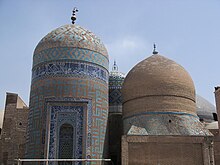Safawiyya
The Safawiyya ( Arabic الصفويّة, DMG aṣ-ṣafawiyya ) was an Islamic Sufi order ( Tariqa ) in Persia and Eastern Anatolia, which had a great influence especially on the Turkmen tribes in Azerbaijan since the 14th century.
founding
Around 1300, the Kurdish Sheikh Safi ad-Din (* 1252, † 1334) , who came from an old resident, respected family, founded a Sufi order in Ardabil (Azerbaijan). It was a good time for Sufis, because official theology had lost much of its importance since the Mongol invasion and the collapse of the previous order . Instead, a popular Islam spread, with belief in miracles, prophecies , cults of saints, centers of pilgrimage , and the mysticism of the Sufi orders fell on fertile ground.
Ascent
The order quickly gained considerable popularity among the Turkmen tribes in Azerbaijan and Eastern Anatolia , as well as an economic power that grew out of the gifts and endowments of its followers and which at least Safi ad-Din used for good causes.
The founder of the order was already accused of having too many disciples to instruct them properly. After all, Safi ad-Din and his immediate successors, despite their reputation, had no political ambitions worth mentioning, which changed in the 15th century with the unchecked rise of the Turkmen. Sheikh Ibrahim (died 1447) accompanied a campaign of Qara Qoyunlu prince Jahan Shah (ruled 1435–1467) against Christian Georgia and was described as "cruel", while Sheikh Junaid (died 1460) in addition to the religious war in foreign countries (attack on Trebizond 1456) instigated surveys against individual provincial governors in Anatolia.
Between 1456 and 1470, the wandering Sheikh Junaid and his underage son Haidar (* 1460, † 1488) were under the protection of Uzun Hasan (r. 1453–1478) by the Aq Qoyunlu . Under these two sheikhs, the order began to gain political importance after leaning towards Shiite Islam and organizing and training an armed following, known as Kizilbash since Haidar introduced a red headdress .
When Haidar attacked the Circassians with superior forces in 1488 and then attacked Shirvan (the latter in revenge for the death of his father), despite the family ties between Haidar and Yaqub (r. 1478-1490), they broke with the Aq Qoyunlu, who saw the Shirvan helped defeat the Safawiyya. Sheikh Haidar fell in the fighting in July 1488, his followers went into hiding for a decade and his sons were detained by the Aq Qoyunlu for several years. Finally, Haidar's son Ali Mirza was killed in 1494 and his brother Ismail I (* 1487, † 1524) had to be hidden from the Aq Qoyunlu by the (Shiite) local prince of Gilan .
Seizure of power in Persia, establishment of a dynasty
The outbreak of dynastic power struggles among the Aq Qoyunlu (after 1490) made it possible for Ismail to regroup his followers in Azerbaijan and Eastern Anatolia. Carried by a tremendous sense of mission, he left his hiding place at the age of 12 and defeated the Shirvan Shah Farrukh Yassar, who fell in battle in 1500. As early as 1501 he was able to defeat the Aq Qoyunlu, conquer Tabriz and found the Safavid dynasty in Persia. Ismail was passionately anti-Sunni and was the first of the sheikhs to undoubtedly belong to the Shiites. The then 14-year-old underpinned his claim to power with his descent from the Prophet (cf. Sayyids ), a claim that was also recognized by opponents of the Safawiyya at the time.
Sheikhs
- Safi ad-Din Ishaq (* 1252, † 1334)
- Sadr ad-Din Musa († 1393, son of Safi ad-Din)
- Sultan Hoga Ali († 1429, son of Sadr ad-Din Musa)
- Ibrahim († 1447, son of Hoga Ali)
- Junaid († 1460, son of Ibrahim)
- Ga'far, brother of Ibrahim (1448–1470 practical head of the order in Ardabil )
- Sheikh Haidar (* 1460, † 1488, son of Junaids)
- Ali Mirza († 1494, eldest son Haidar)
- Ismail I (* 1487, † 1524, son of Haidar)
Remarks
- ↑ Junaid had a falling out with his uncle Ga'far around 1448 and was expelled by Jahan Shah. In his place, Ga'far headed the order in Ardabil, although it is not clear on what basis: order master, guardian or deputy.
- ↑ The dividing lines between Sunnah and Shi'a were blurred and receded into the background in the 15th century. At least Hoga Ali could be assigned to the Shiites on the basis of his name, a dream and his verses in honor of Ali. It is also said of Haidar that Ali appeared to him in a dream, whereupon he introduced the Kizilbasch headgear . The worship of Ali was widespread at this time, even among convinced Sunnis, and so the conversion to Shi'a is only clear with Shah Ismail I. Cf. HR Roemer: Persia on the way to modern times, p. 226ff.
- ↑ Junaid had attacked the Circassians of Tabarsaran (apparently subordinate to the Shirvan Shah) and was captured, defeated and killed by the Shirvan Shah Khalilullah on the march back in March 1460.
- ↑ The Shirvan Shah Khalilullah and the Ottoman Sultan Bayazid used salutations and attributes for the sheiks Junaid and Haidar that only Ali's descendants were entitled to. Cf. HR Roemer: Persia on the way to modern times, p. 232.
literature
- HR Roemer: Persia on the way to modern times, Darmstadt 1989
- Peter Jackson, Laurence Lockhart: The Cambridge History of Iran Vol. 6: The Timurid and Safavid Periods, Cambridge University Press 1986

